Complementary and Alternative Medicine in Psychiatry
The science and art of “healing” as well as the concept of “illness” have always been significantly influenced by the cultural context in which they developed. What most Western medical practitioners conceive of as “health care” is actually quite in its infancy compared with many practices aimed at curing or ameliorating illness that developed across the world for many centuries past. Major advances in biomedical research and in the scientific method in general over the past century have brought that discovery of revolutionary medical interventions that have saved countless lives, most notably through the treatment of infectious illnesses. Yet, many practitioners and patients alike sense that the biological and reductionist concepts of illness and its treatment that have come to guide much of Western medical care often minimize the role of psychosocial factors in health and wellness. Psychiatry itself, supposed champion among medical fields in addressing psychosocial etiologies of illness, has also become increasingly biological in its focus. Although this approach has undoubtedly benefited persons with mental illness and has increased public awareness that the brain is no less a physical organ than the heart or kidney (susceptible to maladies at times through no fault of the person suffering mental illness), some mental health practitioners worry that the “listening care” in psychiatry will become increasingly marginalized. After all, addressing psychosocial aspects of health is almost always more time-consuming than biological interventions and thus, in a short-sighted vision of health outcomes, often seems inefficient and expensive.
The term complementary and alternative medicine (CAM) refers to the various disease-treating or disease-preventing practices whose methods and efficacies differ from traditional or conventional biomedical treatment. Other terms used to describe these therapeutic approaches are integrative medicine and holistic medicine. This is not a new concept in psychiatry. The idea of emphasizing the whole patient and the need to evaluate psychosocial, environmental, and lifestyle factors in health and disease is subsumed under the heading of psychosomatic or mind–body medicine.
Traditional medicine, as practiced in the United States and elsewhere in the Western world, is based on the scientific method—the use of experiments to validate a hypothesis or determine the probability of a theory being correct. Traditional medicine presumes that the body is a biological and physiological system and that disorders have a cause that can be treated with medications, surgery, and complex technological methods to produce a cure. Traditional medicine is thus also referred to as biomedicine or technomedicine.
Traditional medicine is also known as allopathic medicine. The term allopathy, derived from the Greek word allos (“other”), refers to the use of outside agents or medications to counteract the signs and symptoms of disease; for example, antipyretics to treat fever. Allopathy is the type of medicine taught in medical schools in the United States. Samuel Hahnemann (1755–1843), a German physician, coined the term to distinguish this form of medicine from homeopathy (derived from the Greek word homos [“same”]), in which specially formulated medicinal remedies, different from allopathic medicine, are used. Allopathy is the most prevalent form of medicine practiced in the Western world. (Homeopathy is discussed more fully later in this chapter.)
NATIONAL CENTER FOR COMPLEMENTARY MEDICINE AND ALTERNATIVE MEDICINE
The widespread adoption of CAM practices led the US government to establish the National Center for Complementary Medicine and Alternative Medicine (NCCAM) within the National Institutes of Health (NIH). NCCAM’s mission is to evaluate the usefulness and safety of a broad range of unrelated, nonorthodox healing practices and provide scientific explanations for their possible effectiveness, train CAM researchers, and disseminate information to the public. NCCAM has proposed changing its name to the National Center for Research on Complementary and Integrative Health Care (NCRCI).
An NCCAM study in 2011 revealed that close to 40 percent of Americans used some form of CAM within a 12-month period. When prayer was included, the percentage rose to more than 60 percent. Prayer for one’s own health was most prominent, followed by prayer by others for one’s own health, natural products, deep-breathing exercises, group prayer, meditation, chiropractic care, yoga, massage, and diet-based therapies. Echinacea, ginseng, Ginkgo biloba, garlic supplements, glucosamine, and St. John’s wort were among the most common natural products used. Back, head, and neck pain were the most common conditions treated. The CAM practices were most likely to be embraced by those with more education, women, former smokers, and those who had been recently hospitalized. Most users of CAM practices believed the greatest benefits were achieved in combination with conventional treatment.
NCCAM conducts clinical trials at the NIH and academic research institutions to investigate the benefits of various CAM practices on a spectrum of diseases and disorders, ranging from psychiatric conditions to cancer, osteoporosis, and multiple sclerosis, among others. Some completed studies have validated the following: acupuncture is beneficial to treat functional impairment and osteoarthritic pain of the knee; no prophylactic benefit was found for low-dose Echinacea augustifolia in the prevention of cold symptoms; combined glucosamine and chondroitin sulfate supplements do not provide significant relief for osteoarthritic pain in most cases, but does benefit a smaller subset with more severe pain; and St. John’s wort (Hypericum perforatum) is no more effective for treating major depression of moderate severity than placebo. St. John’s wort is being further investigated as a treatment for posttraumatic stress disorder (PTSD), anxiety, and minor depression (see “Herbal Medicine” below).
The NCCAM has compiled a classification of alternative medical practices designed to support research (Table 24-1). Including a practice in the classification does not imply an endorsement of the method. Indeed, many complementary and alternative health practices are based on no known scientific principles and are considered quackery.
 Table 24-1
Table 24-1
Complementary and Alternative Medicine Practices
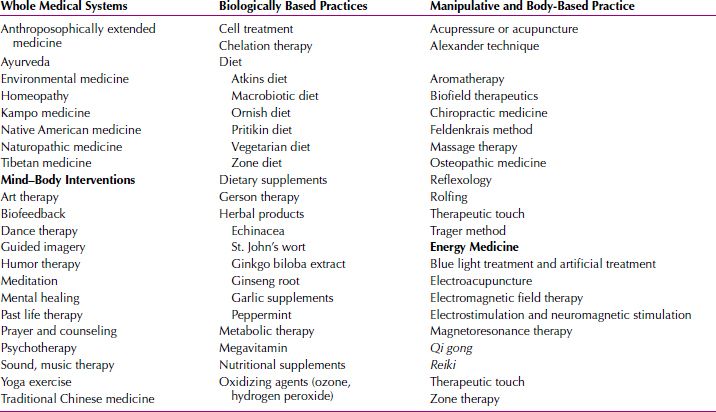
Many systems of treatment discussed in this chapter are centuries old, and it would be presumptuous for traditional biomedical practitioners to dismiss them lightly as worthless. Nevertheless, without rigorous scientific evidence to the contrary, physicians must approach many of these treatments with skepticism. The influence of the mind on the body and the effect of psychological factors in health and disease are well known to physicians, especially to psychiatrists. Suggestion is a potent remedy, and the well-established placebo effect, in which an inert substance is effective in curing a disorder, serves to confirm the importance of mind–body interaction in health and disease.
Currently, more than half of the medical schools in the United States offer some form of complementary and alternative medicine education. Several have developed centers for alternative medicine research, with professors of mind–body or integrative medicine drawn largely from the ranks of such traditional specialties as internal medicine and psychiatry. This trend is likely to continue, with the goal of determining which of the many existing alternative medical systems have scientific merit. Only when and if they can withstand rigorous clinical trials can these techniques be integrated into traditional medicine.
Listed below in alphabetical order are some of the most visible complementary and alternative health practices that have been used in the treatment of (broadly defined) psychiatric conditions. The discussion of therapies should not be considered definitive; new therapies continue to emerge. The number of alternative healing practices available in the United States is unknown and probably soars into the hundreds and their practitioners into the tens of thousands, and there are no national standards set to credential such practitioners.
ACUPRESSURE AND ACUPUNCTURE
Acupressure and acupuncture are Chinese healing techniques that are mentioned in ancient medical texts dating back to 5000 B.C. and continue to be an important medical intervention in the East. A basic tenet of Chinese medicine is the belief that vital energy (qi or chi) flows along specific pathways (meridians) that have about 350 major points (acupoints) whose manipulation corrects imbalances by stimulating or removing blockages to energy flow. Another fundamental concept is the idea of two opposing energy fields (yin and yang) that must be in balance for health to be sustained. In acupressure, the acupoints are manipulated by the fingers; in acupuncture, sterilized silver or gold needles (some the diameter of a human hair) are inserted into the skin to varying depths (0.5 mm to 1.5 cm) and are rotated or left in place for varying periods to correct any imbalance of qi.
In the West, acupressure and acupuncture are explained on the basis of nerve stimulation that releases endogenous neurotransmitters, endorphins, and enkephalins to help cure illness. The benefits of acupuncture have been validated in a variety of conditions, most notably pain management, postoperative nausea and vomiting, osteoarthritis of the knee, fibromyalgia, and headaches. Other conditions treated with these techniques are asthma, dysmenorrhea, cervical pain, insomnia, anxiety, depression, and substance abuse, including smoking cessation (see the description of moxibustion below). Most pain management clinics in the United Kingdom use acupuncture treatment. A variation of acupuncture, which uses mild electric current to augment therapeutic effects (electroacupuncture), is most often used for analgesia or during surgery. Acupuncture applied to the ear (auricolocupuncture) is also common.
ALEXANDER TECHNIQUE
The Alexander technique was developed by F. M. Alexander (1869–1955), who was born in Tasmania and eventually became a well-known stage actor. After developing aphonia, he experimented on himself by changing his body posture and eventually regained his voice. Alexander developed a theory of the proper use of body musculature to help alleviate somatic and mental illnesses. Alexander’s approach is an educational process that reduces habitual, unnecessary muscular tension in everyday movements (i.e., unintentionally straining the neck while sitting at a computer) by improving sensory awareness and conscious control of these maladaptive physical habits (Fig. 24-1). Treatment improves cardiovascular, respiratory, and gastrointestinal functioning as well as mood. A small, devoted group of Alexander practitioners is found in the United States and throughout the world. The Alexander technique holds promise as an approach to pain management; it has been shown to be effective in treating chronic back pain in several recent independent studies (Fig. 24-1).
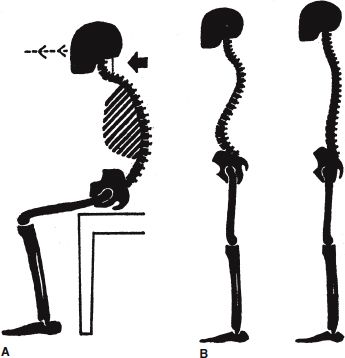
FIGURE 24-1A. Position of pelvis, back, neck, and head in slumped position. B. Standing in hunched position (left) and well balanced (right). (From Barlow W. The Alexander Principle. London: Gollancz; 1973, with permission.)
ANTHROPOSOPHICALLY EXTENDED MEDICINE
Anthroposophically extended medicine is a form of healing developed by the Austrian philosopher Rudolf Steiner (1861–1925). The healing process involves the use of conscious understanding, which Steiner called anthroposophy, or the “wisdom of life.” Anthroposophy focuses on mental exercises that enable persons to find a balance between mind and body to ensure health maintenance. Steiner founded a school of thought represented in this country by the Rudolf Steiner School, which teaches children these concepts as they apply to civilization, besides a standard educational curriculum.
AROMATHERAPY
Aromatherapy is the therapeutic use of plant oils. Named by the French chemist Maurice René-Maurice Gattefossé in 1928, aromatherapy is one of the fastest growing alternative therapies in the United States and Europe. The essential oils of plants are organic compounds that are benzene derivatives. Aromatic substances were used in ancient civilization as both medicines and perfumes. Today, plant oils are inhaled using atomizers or are absorbed through the skin using massage (aromatherapy massage). Plant oils have many therapeutic effects—analgesic, psychological, antimicrobial—some of which have been demonstrated scientifically. One NCCAM study, for example, found the scent of lavender helped promote sleep. Aromatherapy is used to reduce stress and anxiety and to alleviate gastrointestinal and musculoskeletal disorders. In psychiatry, olfactory stimulation has been used to elicit feeling tones, memories, and emotions during psychotherapy. Aromatherapy can cause skin irritation or allergic reactions in some people. Table 24-2 lists the essential oils and their effects.
 Table 24-2
Table 24-2
Common Aromatherapies

Pheromones are chemical substances secreted and smelled by humans, which affect their physiological and behavioral responses, usually related to sex. Women who are exposed to the smell of androstenol, which occurs in male underarm sweat, show increased social exchanges with men, heightened sexual arousal, and improved mood. Androstenol also affects the length and timing of the menstrual cycle as a result of changes in the level and release of gonadotrophic-releasing hormone (GnRH) and luteinizing hormone (LH). Female pheromones, known as copulins, are present in female underarm sweat and in vaginal secretions. Males perceive the odor of copulins as most pleasant during the woman’s ovulatory cycle when such odors are most volatile. The synchronization of the menstrual cycle of women living together (a well-documented phenomenon) is also related to the effect of copulins. Olfactory sexual signaling is being investigated extensively, and whether these studies show therapeutic potential remains to be seen.
AYURVEDA
Ayurveda means “knowledge of life.” The technique originated in India about 3000 B.C. and is believed to be one of the oldest and most comprehensive medical systems in the world. Ayurveda is similar to Chinese medicine in its beliefs about energy points on the body and a vital force (prana) that must be in balance to maintain health. Ayurveda practitioners diagnose illness by examining the pulse, the urine, and the heat or coldness of the body. Treatment relies on diet, medicines, purification, enemas, and bloodletting. (See also “Tibetan Medicine” below.)
BATES METHOD
The Bates method, designed to treat vision problems, was devised by William H. Bates. It is aimed at naturally strengthening the eye muscles and includes the following basic exercises: splashing closed eyes 20 times with warm water, then 20 times with cold water; alternately focusing on near and distant objects; focusing on an object while gently swaying the body; remembering objects in the mind’s eye to facilitate the actual perception of these objects in reality; and closing the eyes, cupping them with the palms of both hands (without touching the eyes), and focusing on pleasant thoughts. Bates practitioners claim that persons who need glasses to correct refraction errors will not need them if these methods are followed rigorously.
BIOENERGETICS
Bioenergetics, based on the belief that dammed-up energy produces maladaptive behavioral patterns, evolved from the work of the Austrian psychoanalyst Wilhelm Reich (1897–1957), who studied with Sigmund Freud. Reich believed that energy fields were propelled by sexual impulses called ergs and that satisfactory orgasms indicated healthy bodily functioning. Modern-day practitioners look for areas of muscular tension in the body that are thought to be associated with repressed memories and emotions. Therapists try to bring these repressions to consciousness through a variety of relaxation techniques, including massage.
CHELATION
Chelation therapy is a traditional medical procedure used to treat accidental poisoning with heavy metals, such as lead, arsenic, and mercury. A chelating agent (ethylenediaminetetraacetic acid [EDTA]) is infused into the bloodstream and binds to the metal, which is then excreted from the body. As an alternative medical practice, chelation therapy is used as a form of preventive medicine to remove lead, cadmium, and aluminum from the body. These substances are presumed by some to be associated with premature aging, memory loss, and the symptoms of Alzheimer’s disease. Chelation therapy has also been used to treat atherosclerosis and coronary artery disease. One NCCAM study showed that chelation treatments reduced cardiovascular events such as heart attacks and death in patients with diabetes; however, chelation therapy is not yet approved by the U.S. Food and Drug Administration (FDA) as a treatment for this condition.
CHIROPRACTIC
Chiropractic is concerned with the diagnosis and treatment of disorders of the musculoskeletal system, especially those of the spine. It was developed by a Canadian, Daniel David Palmer (1845–1913) (Fig. 24-2), who moved to the United States in 1895. Palmer believed that disease could be attributed to spinal misalignment, leading to abnormal nerve transmission.
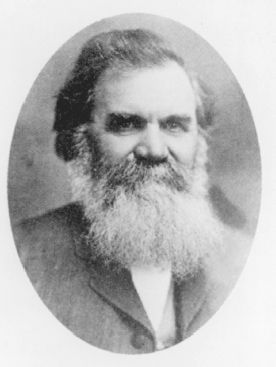
FIGURE 24-2Daniel David Palmer (1845–1913), the founder of chiropractic. (Reprinted with permission from Shealy CN, ed. The Complete Family Guide to Alternative Medicine: An Illustrated Encyclopedia of Natural Healing. New York: Barnes & Noble Books; 1996:39.)
Chiropractors diagnose illness by clinical examination and X-ray. Treatment involves manual manipulation of bones, joints, and musculature to restore biomechanical function. Chiropractic is the largest independent alternative health profession in the Western world, with more than 50,000 chiropractors in the United States. They are recognized by government and insurance agencies and treat more than 20 million persons in the United States annually.
COLONIC IRRIGATION
Colonic irrigation is a technique known since antiquity that consists of flushing the intestinal colon with large quantities of water, sometimes with minerals or other substances (e.g., coffee) added. It is a method used to eliminate autointoxication, a concept originating from the Pasteur Institute in France in 1908 that holds that retained fecal matter and undigested food ferment in the bowel producing toxins that cause disease. Special colon hydrotherapy machines force fluids via the rectum to clean the colon of this matter, thus eliminating such toxins. Colon cleansing using powerful laxatives and enemas is an alternative way of achieving the same result. Anecdotal reports of improved general health as a result of such practices are common; however, there are risks of electrolyte imbalance and intestinal perforation. The practice is poorly regulated, although some states attempt to monitor therapists and equipment.
COLOR THERAPY
In color therapy, different colors are thought to affect mood, and this has been used to address specific health problems. For example, blue is believed to be sedating, and red, excitatory. A Swiss psychologist, Max Lüscher, devised a color test in which a subject’s mood at a particular time is determined by exposing the subject to various colors. Lüscher also experimented with the effect of color on the autonomic nervous system and found that pure red is sympathomimetic and can cause an increase in blood pressure, heart rate, and respiration. Blue is parasympathomimetic and produces the opposite effects.
DANCE THERAPY
Dance therapy was formally recognized in 1942, with the hiring of pioneer dance therapist Marian Chace (1896–1970) at St. Elisabeth’s Hospital in Washington, D.C. The terms dance and movement are used synonymously; however, each actually describes a point of view. Movement encompasses the world of physical motion, whereas dance is a specific creative act within that world. The American Dance Therapy Association defines dance therapy as “the psychotherapeutic use of movement which furthers the emotional and physical integration of the individual.” Dance therapy sessions have four basic goals: the development of body awareness; the expression of feelings; the fostering of interaction and communication; and the integration of the physical, emotional, and social experiences that result in a sense of increased self-confidence and contentment.
DIET AND NUTRITION
Nutritional methods to prevent or cure disease have an important place in modern medicine, and their efficacy has been proved by scientific evidence. The federal government has established recommended daily allowances (RDAs) to meet the nutritional needs of average persons in the United States. Table 24-3 depicts the recommendations for a 40-year-old sedentary man. Whole grain, lean meat, and green vegetable consumption are encouraged, and excess intake of unrefined sugar products is discouraged. Critics have faulted the federal guidelines for being unduly influenced by the meat and dairy industries. Nutritional experts and dieticians have developed alternate recommendations, especially for children, adolescents, diabetics, and pregnant women.
 Table 24-3
Table 24-3
United States Department of Agriculture Food Guide for a 40-Year-Old Sedentary Male

Many alternative diets exist, and specific vitamin and mineral supplementation programs have been developed to deal with specific diseases or bodily processes. Diets low in fat have been recommended for the treatment of cardiovascular disease and diabetes. The Pritikin diet developed by Nathan Pritikin is extremely low in fat (less than 10 percent of daily calories), high in complex carbohydrates, and high in fiber. The Ornish diet, developed by physician Dean Ornish, is vegetarian: No meat, poultry, or fish is allowed, and only 10 percent of calories are obtained from fat. The low carbohydrate, high protein diet developed by Robert Atkins, M.D. (1930–2003) has proved effective in short-term weight loss, most likely because of increased compliance. Concern exists around the risk of ketoacidosis and the lack of long-term studies on health. This diet has also been used to treat refractory childhood epilepsy. All of these diets include an exercise program, a component proved to increase cardiac performance. Studies have shown that weight loss alone can reduce cholesterol, decrease blood pressure, and eliminate the need for drugs in newly diagnosed cases of adult-onset diabetes.
Diets from other cultures may have certain health benefits. In Asia, diets are low in fat, and there is a low incidence of cardiac disease; diets in Mediterranean countries are high in olive oil, garlic, and grains and are associated with a low incidence of colon cancer and cardiac disease. Food allergies have been implicated in many conditions: arthritis, asthma, hyperactivity, and ulcerative colitis, among others.
DIETARY SUPPLEMENTS
In addition to herbs (discussed below), a variety of dietary supplements are used to promote health. Dietary supplements are products that contain vitamins, minerals, or amino acids. In many cases, the supplement is actually an extract, metabolite, or combination of those. They are intended to supplement a healthy diet; they do not comprise a diet or meal. Nutritional supplements have long been familiar to Americans in the form of multivitamins, but they are now available in a vast array of other compounds that can be purchased in grocery stores, pharmacies, health food stores, and over the Internet. Annual sales of dietary supplements in the United States exceeds $20 billion. Of Americans, 75 percent currently use some form of nutritional supplement on a regular basis. Although medicinal benefits are well documented in some supplements, especially vitamins, others vary greatly in safety and consistency. As a general rule, supplements should not be taken by pregnant or lactating women. In psychiatry, nutritional supplements are being used to treat a wide spectrum of illness including cognitive, mood, psychotic, sleep, and conduct disorders; however, little scientific evidence currently supports their efficacy. Table 24-4 lists some of the more common supplements being used to treat psychiatric illness.
 Table 24-4
Table 24-4
Some Dietary Supplements Used in Psychiatry
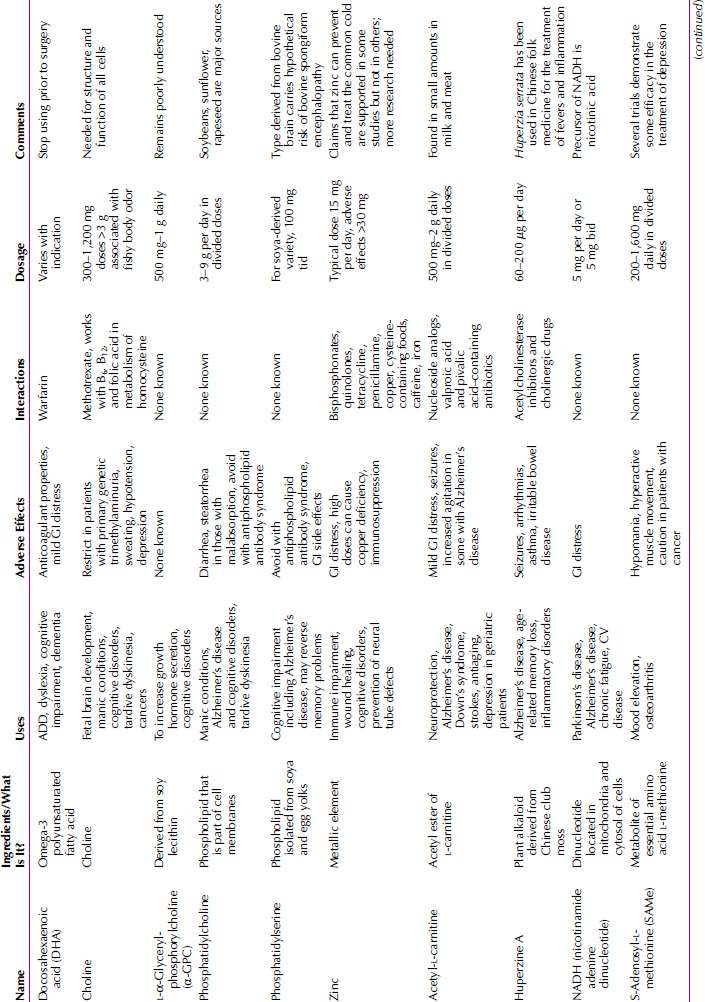
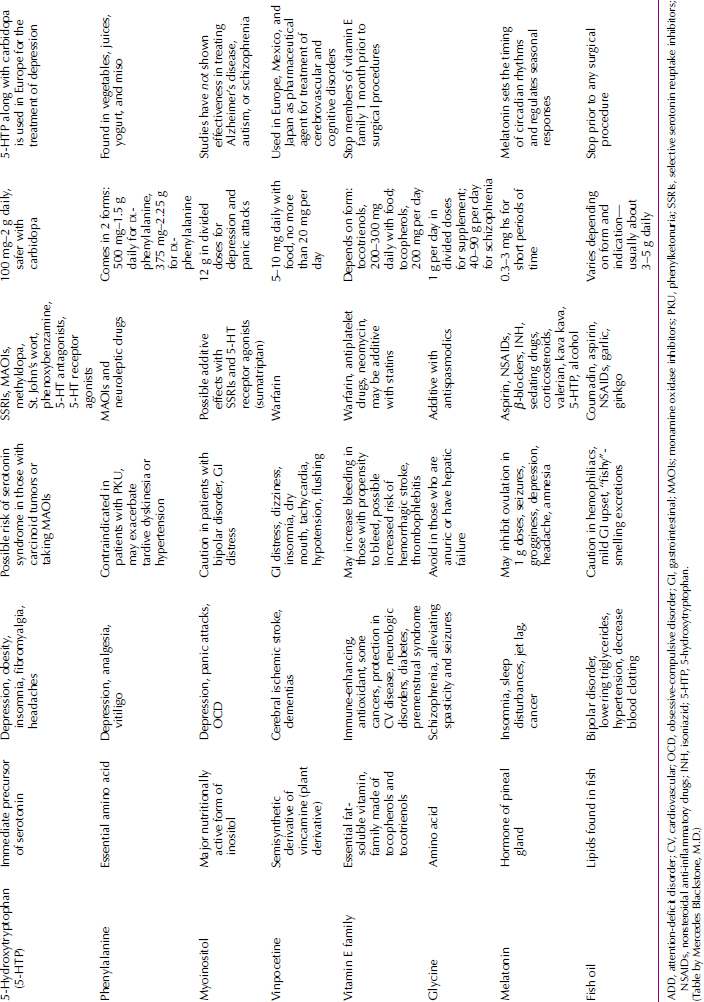
Nutritional status has long been deemed important in mental health, and vitamin deficiencies can produce psychiatric symptoms. Severe niacin deficiency results in pellagra with its characteristic triad of skin lesions, gastrointestinal disorders, and psychiatric symptoms. The psychiatric symptoms include irritability and emotional instability progressing to severe depression and then to disorientation, memory impairment, hallucinations, and paranoia. Folic acid deficiency is associated with depression and dementia, whereas vitamin B12 deficiency is associated with cognitive impairment, depression, and other affective symptoms. Severe malnutrition can result in apathy and emotional instability.
In 1968, the eminent chemist and Nobel Prize–winner Linus Pauling coined the term orthomolecular to refer to the connection between the mind and nutrition. In his book Orthomolecular Psychiatry,
Stay updated, free articles. Join our Telegram channel

Full access? Get Clinical Tree








